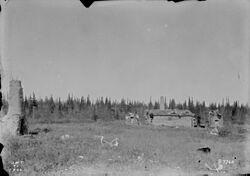Fort Reliance, Northwest Territories facts for kids
Quick facts for kids Fort Reliance, Northwest Territories |
|
|---|---|
| Great Slave Lake, Northwest Territories, Canada. | |

The ruins of Fort Reliance in 1900
|
|
| Type | Winter camp; Trading post |
| Site information | |
| Controlled by | Hudson's Bay Company |
| Official name: Fort Reliance National Historic Site of Canada | |
| Designated: | 1953 |
| Site history | |
| Built | 1833 |
| Materials | logs |
Fort Reliance is a very old site in the Northwest Territories, Canada. It is located on the eastern side of Great Slave Lake. This place was once a fort built by the famous Hudson's Bay Company.
Contents
History of Fort Reliance
Building the First Fort
Fort Reliance was first built in 1833. It was put together by an explorer named George Back. He was leading an expedition to the Arctic Ocean. This trip was partly for science. It was also to look for another missing explorer, John Ross. Fort Reliance served as their winter camp.
Back's fort had a main house. There were also several smaller buildings. All of them were made from logs. The houses had chimneys built from stone and clay. These chimneys helped keep the buildings warm. Today, you can still see the outlines of the log buildings. You can also see the old chimneys and some storage pits.
Rebuilding and Later Use
In 1855, the Hudson's Bay Company rebuilt the fort. A leader named James Anderson oversaw this work. The Anderson River is named after him. The new fort was meant to be a winter home. It was used while people searched for John Franklin's lost expedition. But the fort was left empty again after just one winter.
Fort Reliance was not a place for trading furs. However, later on, trappers used the site. These trappers worked in the Thelon River area. In 1897, an American trapper named Buffalo Jones built a log cabin there. He used one of the old chimneys for his new cabin.
A Special Historic Site
Fort Reliance became a National Historic Site in 1953. Parks Canada describes it as a very old site. They say it was the "oldest continuously operating Hudson's Bay Company post, 1833". Parks Canada works with the Prince of Wales Northern Heritage Centre. They help to protect and save the site. Because of their work, the old chimneys have been fixed up. In 2010, the same area was also named the “Old Fort Reliance Territorial Historic Site.”
The site is now part of the Thaidene Nene National Park Reserve. If this national park is fully created, Fort Reliance will be a special part of it.

